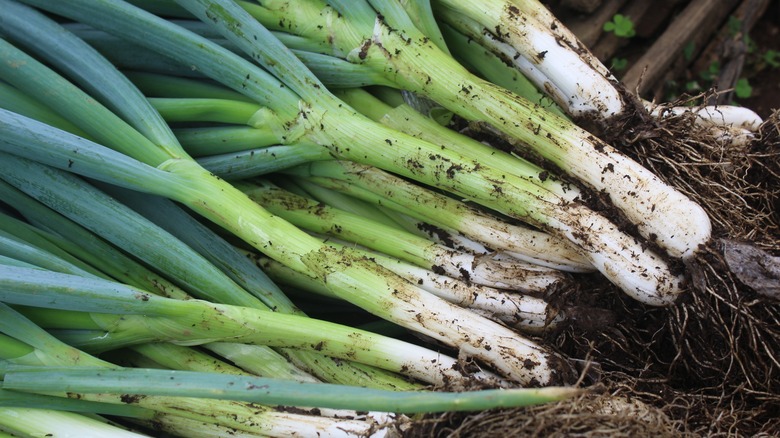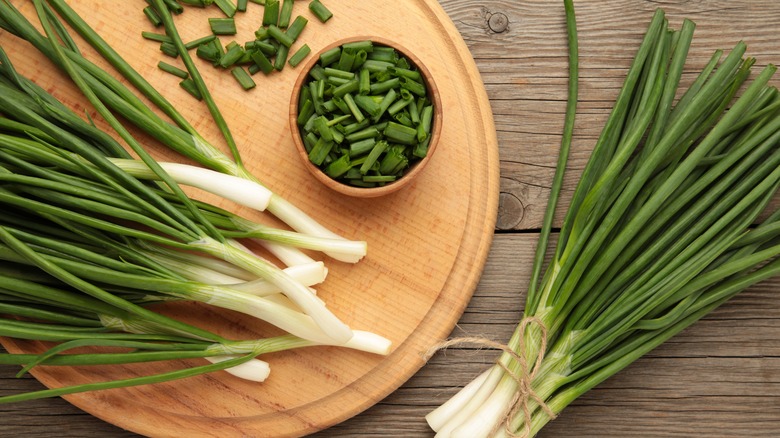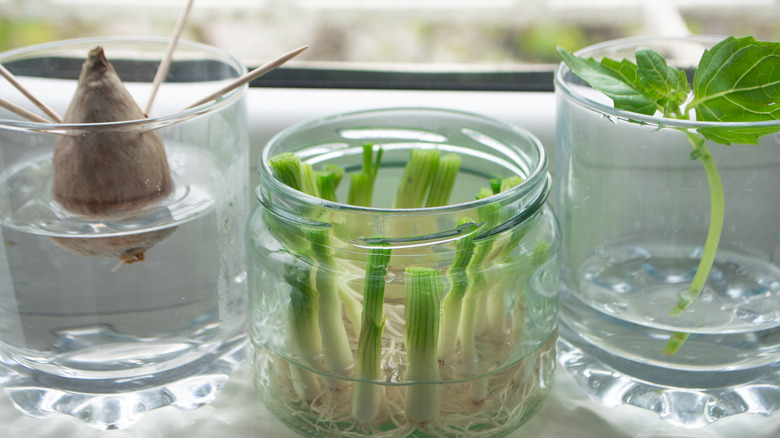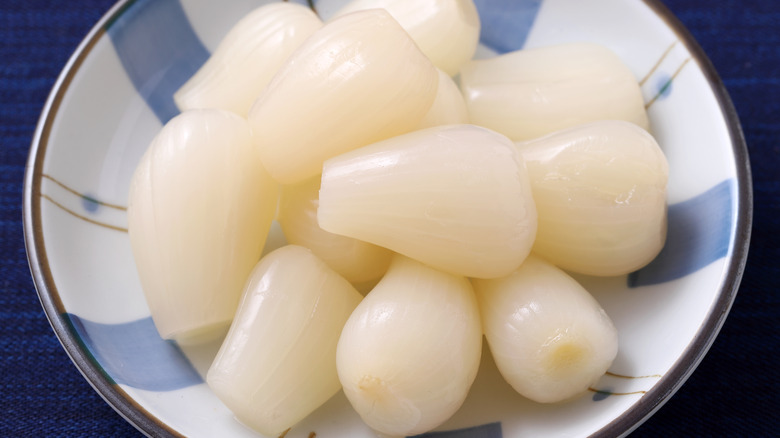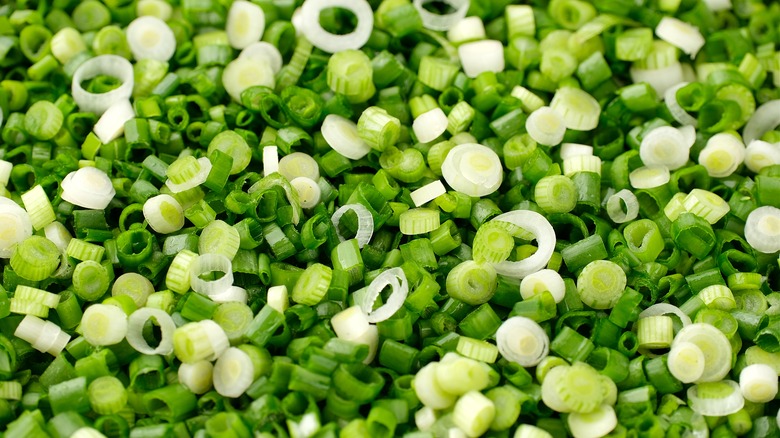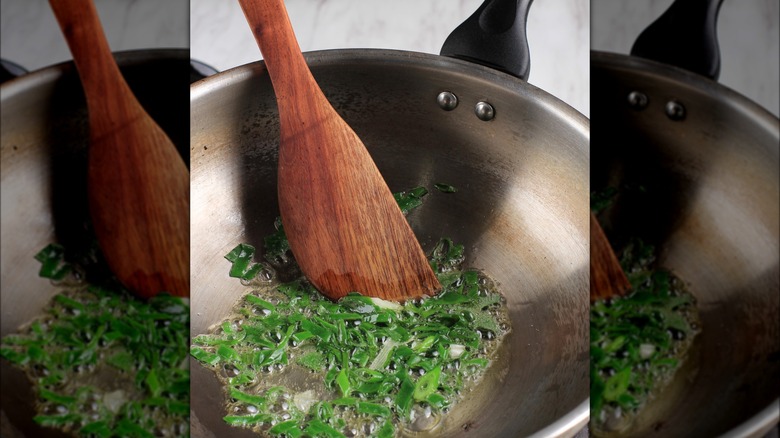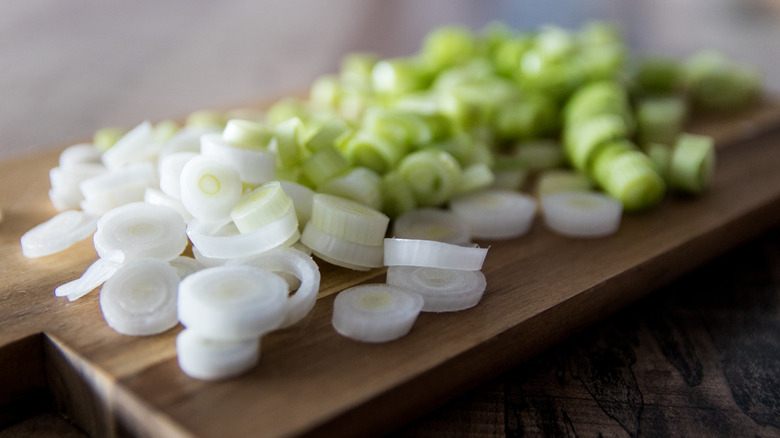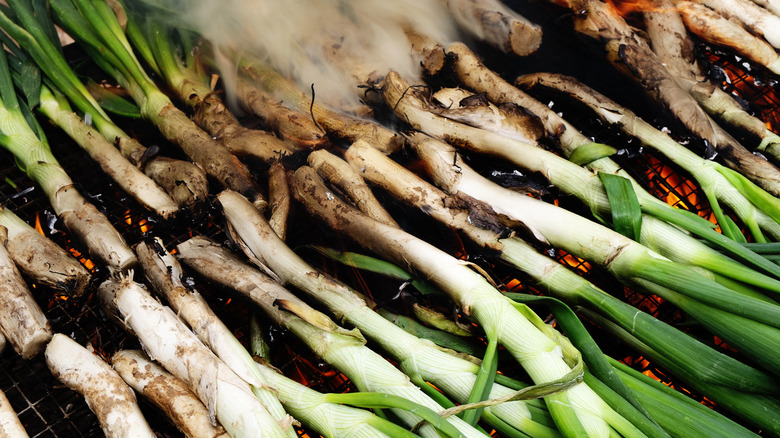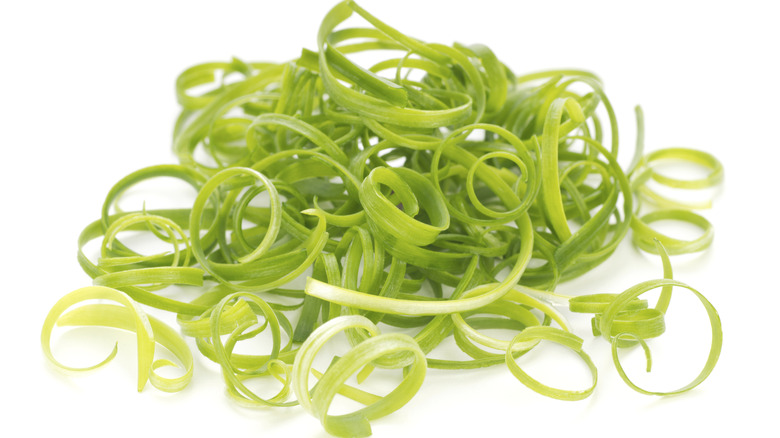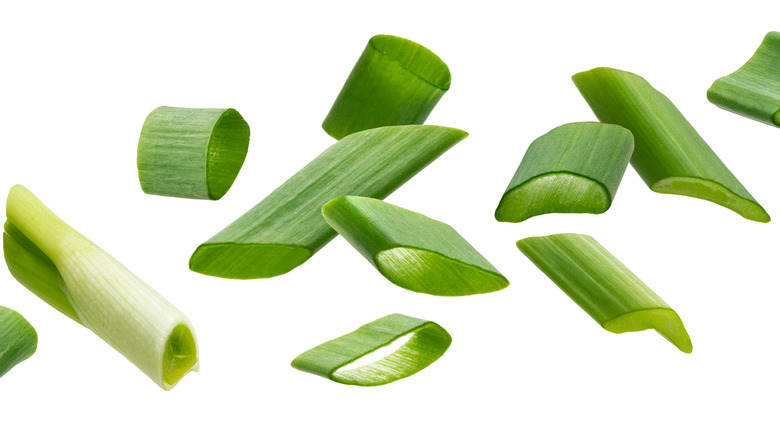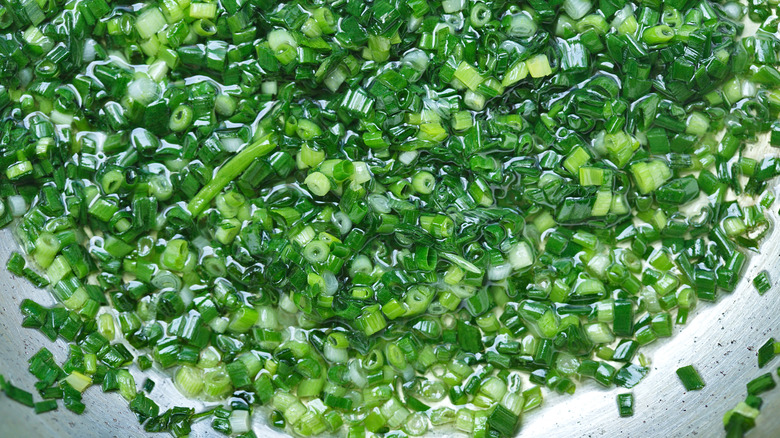The Top 12 Green Onion Hacks Everybody Should Try
Green onions may look simple, but there are more ways to spruce them up than you might think. This easygoing allium is highly versatile, and there are a load of hacks out there that can make it more delicious and give its flavor added complexity. Preparing and storing green onions can also be optimized, and with a few easy tricks, you can chop and curl your onions perfectly in mere seconds — or even use them to prepare your cookware. That's all before you unlock the greatest hack of all: The fact that green onions can be regrown, giving you a nearly infinite supply of them.
You might think that hacking this humble vegetable is pointless, but trust us when we say that it's worth your time. Green onions (also known as scallions) already give any meal a sprightly, lightly savory flavor, with their gentle onion tang useful both as a garnish and a core ingredient. Hacking them, though, amps up their usefulness and their taste, and allows you to master this fridge staple. Ready to revolutionize your green onions? We thought so.
1. Flip your onions over for easy chopping
Green onions aren't overly difficult to chop, but they do suffer from one thing: Their shape. Green onions are tight and firm towards their white ends, but once you get to the green part, they tend to splay outward, getting more fragile. When chopping them, this can lead to some irregularity, and if you're not careful, your knife will start to struggle when you get to the looser parts, leaving you with irregularly cut onions. This is all the more likely when you're cutting them in large batches.
One easy hack for avoiding this involves little more than flipping some of them over. Place your green onions in a line, and then flip every other onion over, so that half of them face the other way. Then, just cut them as normal. By lining up the white ends with the green ones, you ensure that every part of each onion is cut to the same length and size. It's worth bearing in mind that this trick is best if you're planning on using both parts of the onion simultaneously, and not separating the greens from the whites, as they'll all be mixed up.
2. Save your scraps and regrow your onions
Of all the foods you can regrow from kitchen scraps, few are as satisfying, or as simple, as green onions. You know those ragged little white parts on the end of a green onion? Those are its roots, folks — and they're far from dead. By preserving the ends of your green onions, you can regrow an entirely new batch, saving you from having to buy new ones every time you need them.
To regrow green onions, take their white ends and place them in a glass or jar of water, root-side down. Make sure that the tip of the onion is poking out of the water — you probably don't want to cut them too short. Then, pop your container somewhere sunny, and wait. Within a day or two, you should notice that green shoots are beginning to grow from the white parts. Then, after a fortnight, you should be left with new, fully-formed green onions, with the roots way longer and stragglier.
What you do then is entirely up to you. If you wish, you can take them out of the water and use them straight away. Alternatively, if you want massive green onions, take your plants and pot them in some soil. They'll continue to grow until you're ready to cook with them.
3. Pickle your green onions for a fresh twist
Green onions are most commonly enjoyed fresh, and we can understand why: Their zippy, bright flavor is excellent at lifting any dish. However, preserving them is not only entirely possible but gives them a brand-new taste. Green onions are especially well-suited to quick pickling, thanks to their delicate structure, which absorbs the briny notes of your pickling solution fast and gives you a crunchy, sour snack in just a few days.
To quick pickle your wilting veggies and give them a new lease of life, first cut your green onions down to the size of your container. It's usually best to use the firmer part of the green onion here: While you can use the green, delicate ends, they're at risk of losing their crispness when pickled. Once you've packed your onions into your jar, pour your hot pickling solution over them before leaving the onions to soak up all of the flavors for 48 hours. Once your pickled green onions are ready, you can enjoy them on their own as a snack, or tuck them into a sandwich for a pop of acidity. Alternatively, slice them up and throw them onto a salad.
4. Freeze your green onions to use them easily
Have you ever bought a bunch of green onions, only to find that you don't need the majority of them? If so, you're not alone — way too many of us end up throwing out half of our produce once it's had a chance to wilt into lifelessness for a few days in the fridge. You can avoid this, and other mistakes when storing your onions, by freezing your little green friends. This is a particularly useful trick if you can't store your green onions in water to keep them fresh, or have just bought way too many.
You first need to make sure that your green onions are clean and dry. Then, slice them up and pop them into a freezer-safe bag or container. Once frozen, your green onions will stay fresh for around three to four months. Using them is as simple as pulling them out of the freezer, leaving them to thaw (which won't take long, thanks to their small size), and putting them into, or onto, your food. It's important to remember that frozen green onions won't have exactly the same texture as fresh ones once thawed, and they may be slightly less crisp or juicy. As such, it's usually best to use frozen green onions in recipes like soups or stews, instead of places where you'd use fresh ones.
5. Use them to season your wok
Green onions aren't just good for cooking with — they're also good for preparing your cookware. One of the most common mistakes people make with their wok is not seasoning it. Seasoning a carbon steel wok involves heating oil to a super-high temperature and using it to coat the inside of the pan, creating a natural nonstick surface that can tolerate the searing temperatures required for cooking. Making sure that oil gets into every nook and cranny of the wok, though, is tricky, and frying green onions in it ensures that everything is coated nicely.
Using green onions also helps to reduce the amount of smoke kicked out by your wok and the oil inside it. Plus, it releases a pleasant aroma into your kitchen, and who wouldn't want that? You likely won't want to use the green onions after you're finished, considering that you'll need to stir-fry them for around 15 to 20 minutes. However, this is a great way to use leftover green onions and put them to good use, instead of contributing to unnecessary food waste.
6. Make super-easy scallion pancakes with just a few ingredients
Scallion pancakes are one of life's great pleasures. Making them, however, isn't always as fun as eating them. Not all of us have time or energy to pull together the dough when we want this crispy snack — but luckily, there's an easy hack to hand, in the form of wonton wrappers.
With just some wrappers and some green onions, you can make scallion pancakes in mere minutes. This is just one of many things you can make with wonton wrappers, and they work especially well here, as they have the same flavor profile as homemade pancake dough, making them a straight swap. Simply take your wrappers out of the fridge and allow them to come to room temperature, before peeling one off, laying it flat, and sprinkling it with green onions. Then just layer another wrapper on top of the first one, sandwiching the green onions between the two. Press a rolling pin down on the wrapper, easing out the dough until it's a flatter, wider shape, before frying it. Take it off the heat and cut it into quarters, before serving with your favorite dipping sauce.
7. Use your scallions to make a medicinal tea
Green onions aren't just for eating, folks. Their delicate flavor and aroma make them a natural fit for infused drinks, with ginger-scallion root tea being one of our favorites. This tea is a classic Chinese curative, typically used when folks are suffering from a cold or the flu. The ginger is particularly useful here, thanks to its anti-inflammatory and antiviral qualities, as well as its warming taste. The green onions have some mild anti-bacterial properties of their own, but also give the beverage a light fragrance which pairs wonderfully with the sharper ginger notes.
Making ginger-scallion root tea is a breeze. Simply throw six to eight ginger slices in a pot with the same amount of green onions, with the green parts chopped off. Pour over a few cups of water, and if you want a little sweetness or salt, add in some sugar or a pinch of sea salt. Simmer it all together, allowing the heat to extract the flavors of your aromatics for around 10 minutes. Then, strain off the liquid, allow it to cool for a moment or two, and then drink, feeling that wholesomeness work its way through you.
8. Char your green onions for instant flavor
Green onions have a lot more flavor than they get credit for. While most of us are familiar with their bright, sharp raw flavor, something special happens when they're charred. Blackening green onions, either on your grill or in a skillet, removes their slightly acrid edge, unlocking both their smokiness and sweetness. It also gives them a soft creaminess in their center and heightens their aroma tenfold.
The best part is that charring green onions is both easy and quick, as they take just seconds to develop a dark crust. Once cooked, they can be used extensively — but they're perhaps their best use is in salad dressings. Adding charred green onions to salad dressings deepens their flavor and offsets their sharp vinegariness with savory depth. In a creamy salad dressing, this gives you a mellow, lightly umami flavor, and a smoky scent that stops the taste from being too dense. Charred green onions are also dynamite in a burger — chop them roughly and pile them on top of your beef patty or fried chicken fillet, and prepare for a flavor explosion.
9. Use the green ends to make a fancy garnish
Green onion curls are an undeniably impressive garnish. Not only do they give any food the allium's trademark zippy flavor, but they do so in a visually appealing way. If you thought that green onion curls were the reserve of gourmet chefs, however, then you're mistaken. Green onion curls can be easily achieved at home, using little more than a sharp knife.
Take your green onions, and lay them out lengthways, before grabbing an ultra-sharp knife and cutting them into long, thin, julienned strips. You can also buy a scallion cutter online for just a few bucks, but if you're not going to do this hack very often, a knife will be perfectly adequate — it'll just take slightly longer. Once you've cut out your strips, place them in a bowl of ice-cold water. The temperature will cause your green onions to curl up. You can either use your green onion curls immediately or pop them in a plastic bag in the refrigerator for a few days. Just make sure you dry them off before you use them, though, to avoid transferring water to your food.
10. Salt your green onions to preserve them
Green onions are tender vegetables that tend to wilt and lose their freshness fairly quickly. That's why we love preserving them. One of our favorite ways to do this is by making herbes salées, or salted green onions. This Acadian method has stood the test of time and extends the lifespan of your green onions significantly while giving them a pop of salty flavor.
Making herbes salées is pretty simple. Cut up your green onions as you normally would, into small rounds. Pack a layer of them into a jar, and then sprinkle it with some sea salt, before repeating until you have several layers of salted onions. Seal the container, and pop it in the fridge. That's it! As your onions sit, they'll absorb the salt, taking on extra flavor and staying fresh and edible. You can use herbes salées for anything, although they're especially good as a garnish for soup or stew, or stirred into mashed potatoes. You can also pack in some extra herbs with your herbes salées, to give them even more fragrance. When using them, just make sure you're compensating for their salt content by reducing it elsewhere in your dish, to avoid making everything too salty.
11. Make a scallion oil with your onions
Few culinary creations are as delicious as scallion oil. This oil harnesses the deep fragrance of green onions and their bright, clean flavor, and is as good drizzled over food as it is as a dip, or an ingredient itself. Making scallion oil is as simple as chopping it finely, mixing it with a natural-tasting oil, and allowing it to steep. If you wish, you can throw additional aromatics in, like ginger, for a sharper, more layered taste. You can also cook your oil with the scallions inside, creating a deeper, more savory flavor (and leaving you with juicy, oily scallions to add to another dish afterward).
Once prepared, you can use your scallion oil in multiple ways, but our favorite is as part of a noodle sauce. Pour a little scallion oil into the bottom of a bowl, along with some soy sauce, and tip hot noodles in, tossing them thoroughly to absorb all of the flavor. We would recommend avoiding using scallion oil as a cooking oil, though. The high temperatures can reduce its aromatic qualities, and make the oil taste pretty dull.
12. Clean your onions in vinegar to remove slime
How often have you started chopping scallions, only to find that they're pretty slimy? It's more common than you think — but thankfully, it's not harmful. While slimy scallions may be pretty gross, it's often just due to a membrane inside the vegetable's layers. While it might be more common with older onions, it can happen when they're fresh, too. This is nothing to worry about unless that sliminess is accompanied by discoloration or a strange smell.
However, it's not exactly pleasant to eat slimy onions. That's why you'll love this hack to remove the slime easily. After slicing your green onions, place them in a bowl of cold water. Pour in a tablespoon of white vinegar and mix everything together, before draining the onions and rinsing them to remove the excess acid. When you rinse them, the slime should rinse away too, having been loosened by the water and vinegar. You can also remove the slime by hand, using a paper towel to rub it off your onions. Let's be real, though — who has the time for that?
